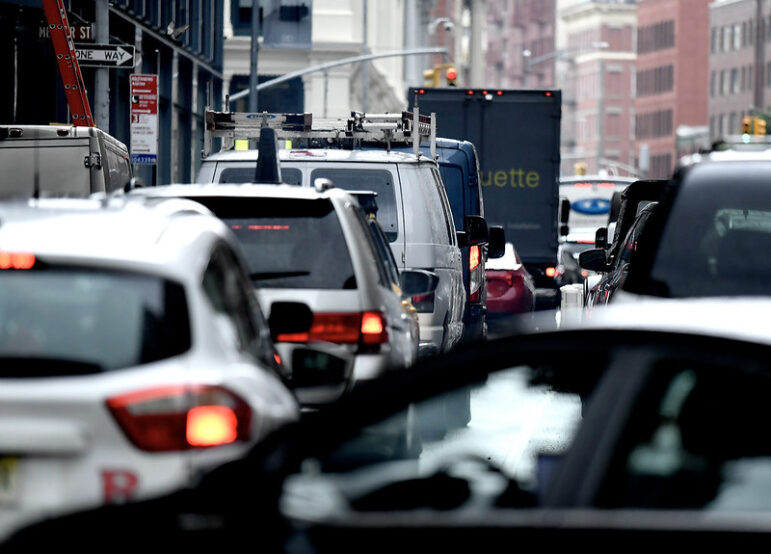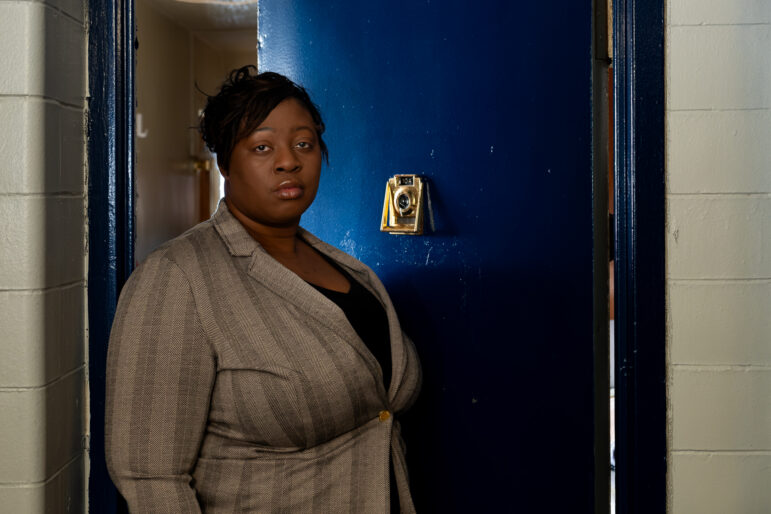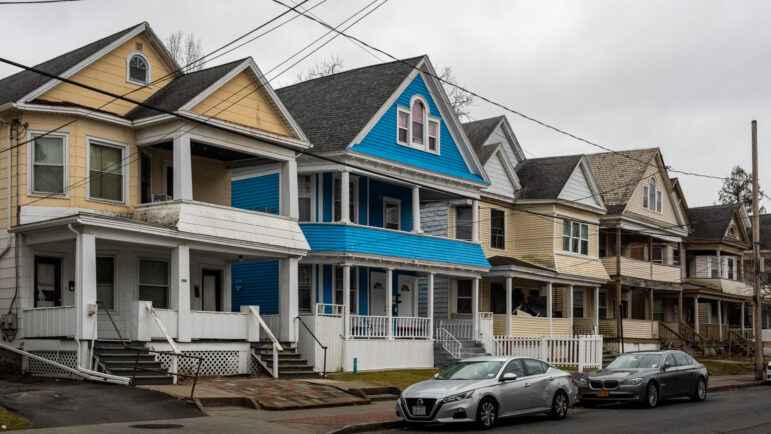When it comes to Red Hook, it seems the more things change, the more they stay the same. Twenty years after this article was published, this isolated bit of Brooklyn has seen a surge of restaurant and housing development, followed by a recent falling-off of gentrification momentum, coupled with the city’s apparent desire to keep a working waterfront there, with cruise ships docking next to freighters – not instead of them. Comparing these excerpts from the original magazine piece to today’s realities suggest that Red Hook is still in the midst of becoming – with its next act always around the corner.
City Limits Magazine, August/September 1987, Volume XII, No. 7
Red Hook: Gloom With A View
Among the gentrified and renovated communities of downtown Brooklyn, Red Hook remains the great outback. Its potholed streets are lined with vacant warehouses and abandoned storefronts, its waterfront decimated by rotting piers and dilapidated rowhouses. Red Hook’s 11,000 residents are overwhelmingly poor—63 percent of them earn less than $10,000 per year—and mostly black and Hispanic.
There is no subway stop in Red Hook. The two bus lines that serve the community run “when they want,” says one resident. There are no hardware or variety stores, no movie theatres and few social or cultural activities. The most conspicuous trade is drug dealing. But in the evenings, after the heavy truck traffic and noxious fumes of the day have died down, residents still drag their lawn chairs out to the sidewalks or gather in front of the bodegas to talk and catch a glimpse of the view of the river. Red Hook’s residents have become accustomed to the area’s isolation and inconvenience.
In the early 1900s, Columbia and Union Streets overflowed with fish stands, delicatessens and bakeries, drawing costumers from all over Brooklyn. A once-thriving port, Red Hook tumbled when containerization revolutionized the shipping industry. In 1964, Borough President Abe Stark proposed a modern industrial park that would cover 230 acres from the piers to the highway. But the plan stalled in the high echelons of city and state bureaucracy, while property owners, under the threat of condemnation, let their buildings decay. The facility finally opened in 1981, reduced from 230 acres to 30.
…Now Red Hook suffers primarily from years of neglect. “We are the step-child or the child no one wants to hear about,” says [Francis] Twomey, [head of the Red Hook Civic Association]. “Road work that takes a matter of weeks in other areas takes months in Red Hook.”
The community’s schools are dismal. The Board of Education has threatened to close P.S.15, one of two local elementary schools, unless plummeting math and reading scores improve by 1990. To get to I.S. 142, Red Hook children have to cross the BQE, and the nearest high school is in Park Slope. “Maybe that’s why our kids down here drop out of school after fifth grade at 50 percent,” says [Veronique] LeMelle, [Van Brunt Street resident and former director of Red Hook Arts, the community’s lone cultural organization].
Health services are another major problem. “Red Hook has the highest concentration of indigent seniors in the city, a high rate of teenage pregnancy, venereal disease and, more recently, AIDS,” says Dr. Socoro Vincente of the South Brooklyn Health Center on Richards Street. The center itself has a troubled history – including embezzlement by a former director – but it is the only clinic in Red Hook. “We have a sliding scale of $75 to $15. Most people pay $15 but some can’t afford to pay that,” she says.
Red Hook Prevention, a Catholic organization providing the only family counseling in the area, cannot meet the demand for help. “We are overextended,” says Aixa Beauchamp of the Catholic Guardian Society. “Two months ago we had a waiting list of 50 families. We refer people to organizations outside the area, but a lot of times we have to accompany them or they won’t go.”
There’s a reason they don’t go. “People can’t leave,” says LeMelle. “It’s a two-fare zone. When you have three kids and you are on welfare—you just can’t leave.”
Three-quarters of Red Hook’s population lives in Red Hook Houses, the fourth largest and one of the oldest housing authority projects in the city. To the residents, 30 percent of whom are on welfare and 40 percent of whom are single parents, life in Red Hook houses can be a nightmare. Trash litters the hallways and the grounds. “The elevators are an experience and the smell alone would kill you, says LeMelle. “But it’s not the residents, it’s the drug dealers.”
…Decades of city indifference has taken its toll on the sprits of the community. “Apathy—in some ways that’s what’s wrong with Red Hook,” opines LeMelle. “I’ve worked in Harlem and it’s different, because at least in other areas there’s tension, and tension is energy you can funnel. Everybody (here) knows they want to change things, but there’s not a lot of energy to create change.”
Even at the most local level of government, the community board, Red Hook plays second fiddle. Red Hook must compete for Community Board 6 attention with neighborhoods like Park Slope. “We’re underrepresented,” says Francis Twomey. “We happen to be the most sought after in terms of land, but on the land-use committee, there’s not one board member from Red Hook. How can we possibly have any influence?”
After years of having other people make plans for them, there are signs that some Red Hook residents are ready to take charge of the community’s fate. The one active community group, the three-year-old Red Hook Civic Association, has until recently represented the interests of the predominantly white homeowners near Van Brunt Street.
…Red Hook is hardly a gentrifiers’ paradise, but the local real estate market is heating up. A recent auction of a small city-owned lot started a bidding war that escalated from $20,000 to $325,000.
The change began with Columbia Street—the area that had been most devastated. In 1984, Columbia Terrace, a subsidized apartment complex, intended for mixed income, opened. The first 51 units sold for $57,000 to $63,000. By the time the fifth phase, now under construction, is complete, the apartments will go for market rates. “Many of the buildings between Hicks and Columbia have already been renovated,” says Brian Sullivan, senior planner at Pratt Institute Center. “It’s really strange to drive down there and see all these signs for co-ops.”
“Nobody ever thought Red Hook would be gentrified,” says Richard Gins, who bought and renovated a three-story firehouse on Van Brunt Street “for a song.”
“Four years ago it was like a war zone, just vacant lots and abandoned buildings,” he says. But the area’s harbor views, proximity to Manhattan and relatively cheap land have brought real estate agencies and speculators in droves.








